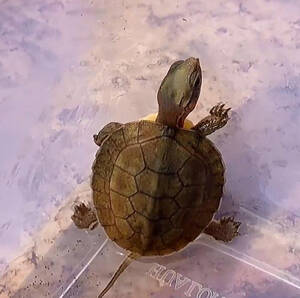Manouria impressa
IUCN
LCBasic Information
Scientific classification
- name:Manouria impressa
- Scientific Name:Manouria impressa,Impressed Tortoise, Kirin tortoise
- Outline:Testudines
- Family:Testudinata Testudinidae
Vital signs
- length:212-238mm
- Weight:250-750g
- lifetime:80years
Feature
As the name suggests, the carapace is flat and even concave in the middle, forming a groove with three horizontal lines.
Distribution and Habitat
In China, it is distributed in Hainan, Guangxi, and Yunnan. Abroad, it is distributed in Cambodia, Malaysia, Myanmar, Thailand, Vietnam, and Laos.
In nature, it lives in forests above 1,200 meters above sea level and feeds on plants.
Appearance
The head is scaly, with a slightly hooked upper edge and no fine serrations on the lower edge. The front and rear edges of the carapace are serrated (more obvious in young turtles) and curled upwards. The head is yellow, tending to light yellow, with black spots. The carapace and plastron are yellow, with irregular black spots. The limbs are brown, with black scales. The tail is black.
Details
Concave-shelled tortoise lives in tropical and subtropical mountainous areas. Adults live on the banks of mountain streams, and young turtles can climb up to the banks and lie horizontally on tree trunks to bask in the sun. They live far away from water and have a narrow distribution area. They feed on bamboo shoots, young grass, and fruits. Under artificial breeding conditions, they are fed with vegetables, fruits, etc. They hide during the day and are active at dawn and dusk. Its suitable living temperature is 20-30℃. When the temperature is above 30℃, it becomes more dependent on water, drinks water frequently, and sometimes lies quietly in a puddle for a few minutes. When the temperature is below 18℃, the turtle's activity decreases, and it gradually enters a hibernation state in the sand or cave.

The concave-shelled tortoise is timid in nature. When frightened, it retracts its head into the shell and immediately stretches it out again, repeating this over and over again, and making a "chi, chi" sound of deflation from its mouth. If caught by someone, it will open its mouth and bite people. The concave-shelled tortoise is a nest-loving tortoise with a relatively fixed habitat. It is afraid of hot and dry weather, prefers cool and humid weather, and likes to hide under leaves and broken rotten plants. Female tortoises do not dig holes like most tortoises to lay eggs, but gather leaves together, lay eggs on the pile of leaves, and cover them with leaves. Reproduction method: oviparous. Reproduction in the rainy season. Each nest lays about 12 eggs.

Listed in the "List of National Key Protected Wildlife in China" - Level II.
Listed as the first level of the "List of Nationally Protected Wildlife in China"








